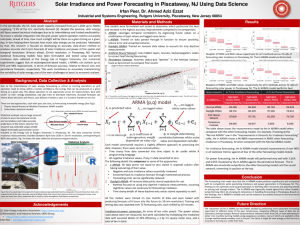Peer Irfan: Solar Irradiance and Power Forecasting in Piscataway, NJ Using Data Science

Title: Solar Irradiance and Power Forecasting in Piscataway, NJ Using Data Science
Name: Irfan Peer
Major: Computer Engineering
School affiliation: School of Engineering
Programs: Aresty Summer Science Program
Other contributors: Ahmed Aziz Ezzat
Abstract: In the last decade, the US. Solar power capacity increased from just 1.2GW up to 70GW, supplying ~ 2.5% of the U.S. electricity demand. Despite the promise, solar energy still faces several technical challenges due to its intermittency and limited predictability. To ensure a reliable integration into the grid, power system operators need to accurately anticipate, ahead of time, how much sunlight will be there on a given timing on a given day, in turn helping them forecast how much solar energy can be produced. Motivated by that, this research is focused on developing an accurate, data-driven method to produce accurate short-term forecasts of solar irradiance and power at fine spatial and temporal resolutions (6-hours ahead, 10-min resolution, in Piscataway, NJ). Various statistical forecasting models have been formulated and tested using real-world irradiance data collected at the Energy Lab at Rutgers University. Our numerical experiments suggest that an autoregressive-based model, L-ARIMA, can achieve up to 97% and 94% improvement, in terms of forecast accuracy, relative to Neural nets and persistence forecasts, respectively. This work contributes to accurately characterizingthe variability of solar energy, one of the main challenges to boost its economic outlook.